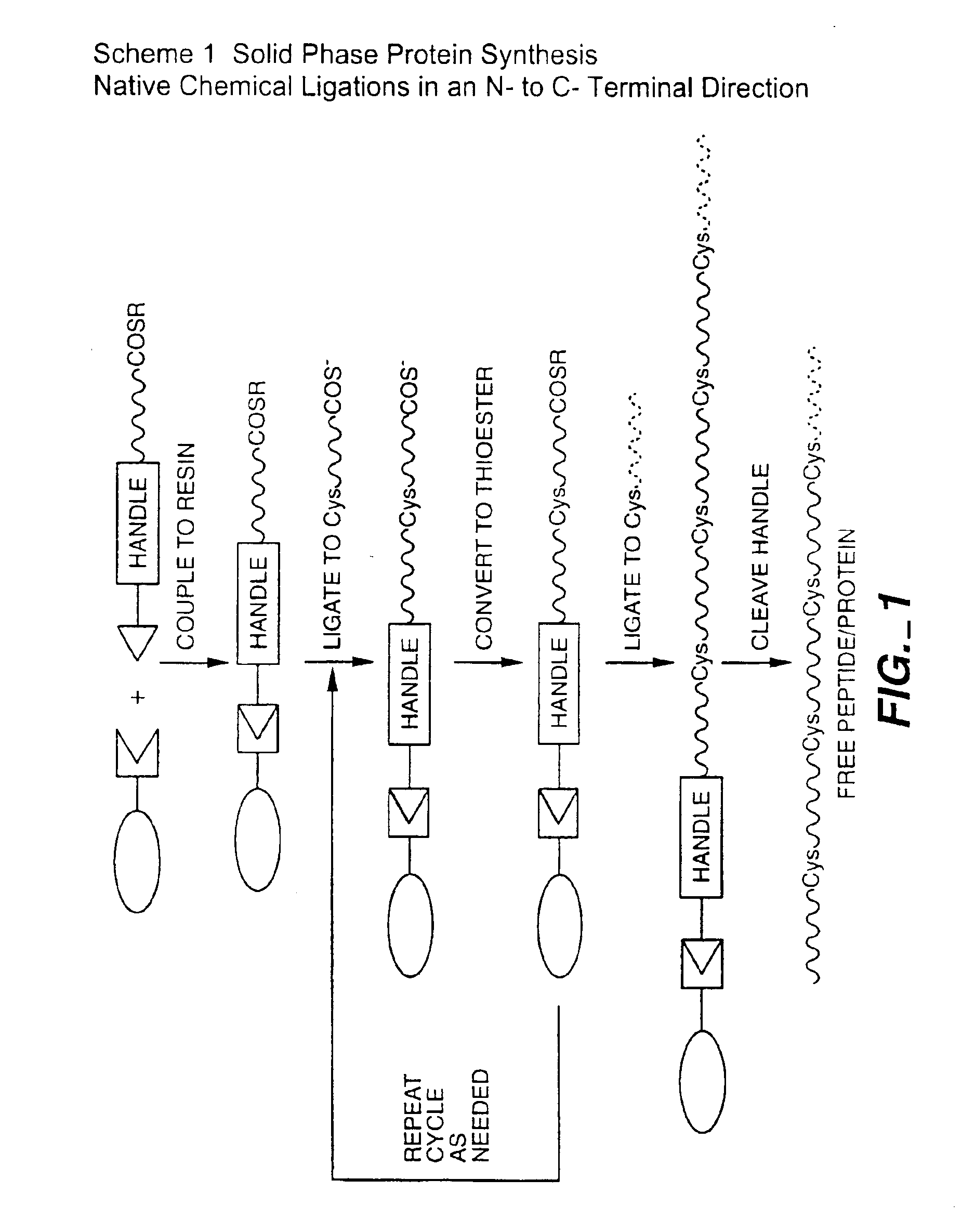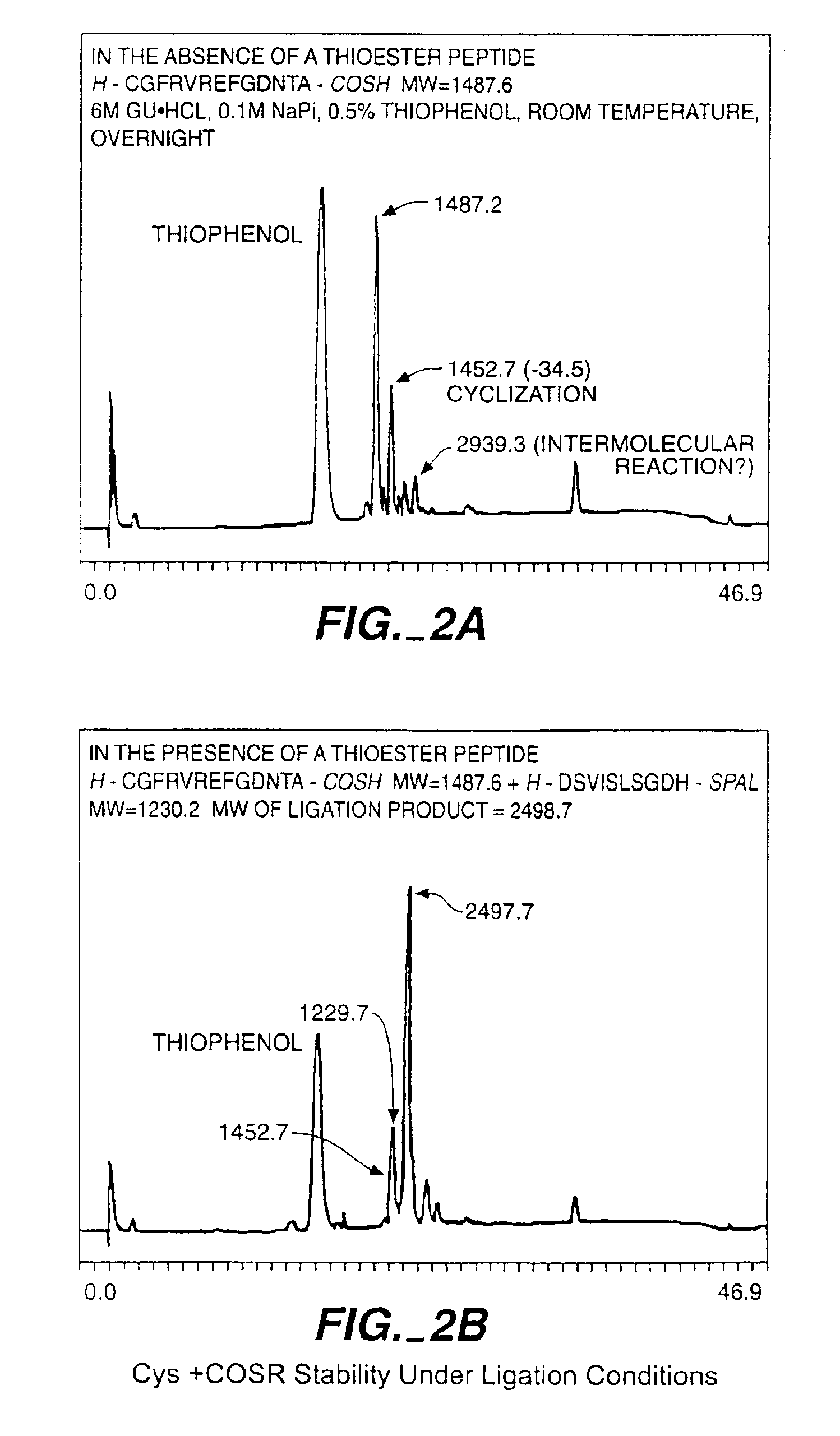Solid phase native chemical ligation of unprotected or N-terminal cysteine protected peptides in aqueous solution
a technology of native chemical ligation and unprotected or n-terminal cysteine, which is applied in the direction of peptides, peptide/protein ingredients, immunoglobulins, etc., can solve the problem of stepwise solid phase synthesis approach size limitations, the formation of solid-phase bound products, and the difficulty of obtaining high-purity well-defined products, etc. problem, to achieve the effect of rapid synthesis, rapid ligation reaction, and easy purification
- Summary
- Abstract
- Description
- Claims
- Application Information
AI Technical Summary
Benefits of technology
Problems solved by technology
Method used
Image
Examples
example 1
Preparation of the Solid Phase for N- to C-terminal Ligations
[0140]The preparation of the solid phase is schematically diagrammed in FIG. 5. The solid phase is a resin, for example, Amino PEGA (0.2-0.4 mmol / g swelled in methanol) or an amino-Spherilose affinity resin (15-20 Tmol / ml, 0.6-0.9 mmol / g dry resin), available from Pharmacia, NovaSyn or Isco. The resin (PEGA or Isco) is washed with DMF (dimethylformamide), then is washed briefly with 10% DIEA (diisopropyl ethylamine). Two 30 sec DMF flow washes are used. A photocleavable linker (PCL) (See FIG. 5A) is activated with one equivalent of HBTU (2-(1H-benzotriazol-1-yl)-1,1,3,3-tetramethyl-uronium hexafluorophosphate) and DIEA in DMF for 5-10 min). This activated photocleavable linker is then added to the resin and is left standing at room temperature for 3 hrs (ninhydrin can be used with Isco).
Two 30 sec. DMF flow washes are used, followed by TFA (1 min×2), and two more 30 sec. DMF flow washes. The remaining steps are in abbrevia...
example 2
Preparation of the First Unprotected Peptide Segment for N- to C-terminal Ligations
[0151]The following procedures are used to prepare the first peptide segment (N-terminus), which is diagrammed in FIGS. 6, 7A and 7B.
[0152]The peptide-resin is swelled in DMF[0153]TFA (1 min×2)[0154]DMF flow wash (30 sec×2)[0155]10% DIEA (1 min×2)[0156]DMF flow wash (30 sec×2)[0157]Addition of MSC handle in DMF[0158]leave standing at room temperature for 1 hr[0159]add DIEA and leave standing for another hr[0160]use ninhydrin test to verify adequate coupling[0161]DMF flow wash (30 sec×2)[0162]TFA(1 min×2)[0163]DMF flow wash (30 sec×2)[0164]10% DIEA (1 min×2)[0165]DMF flow wash (30 sec×2)[0166]addition of activated levulinic acid (activated as the symmetric anhydride with 0.5 equivalents of DIC in DCM for 5-10 min)[0167]leave standing at room temperature for 30 min[0168]ninhydrin test to verify adequate ligating[0169]DMF flow wash (30 sec×2)[0170]thorough washing with DCM[0171]dry on lyophilizer[0172]HF...
example 3
Solid Phase Native Chemical Ligation of Random Peptide Segments in Aqueous Solution in the N- to C-terminus Direction
[0177]The following procedures are used for solid phase ligations in the N- to C-terminus direction, as diagrammed in Table 1. General principals of native chemical ligation are described in WO 96 / 34878, PCT / US95 / 05668, incorporated herein by reference.
[0178]The resin is washed with 6 M guanidine.HCl, 0.1 M Na Acetate, pH 4.6 (1 ml×5) and drained. The modified N-terminal peptide segment is dissolved in 6 M guanidine.HCl, 0.1 M Na Acetate, pH 4.6 and added to resin and is left standing at room temperature overnight. (The concentration of the first segment is at least 5 mM). The next morning, resin is washed with 6 M guanidine.HCl, 0.1 M Na Acetate, pH 4.6 (1 ml×5) and drained. A sample of resin is removed for MALDI MS analysis and is washed with 50%B, MeOH, DCM and dried. A sample of resin is removed for base cleavage and is treated with 200 μl 6 M guanidine.HCl, 0.1 M...
PUM
| Property | Measurement | Unit |
|---|---|---|
| pH | aaaaa | aaaaa |
| pH | aaaaa | aaaaa |
| mass | aaaaa | aaaaa |
Abstract
Description
Claims
Application Information
 Login to View More
Login to View More - R&D
- Intellectual Property
- Life Sciences
- Materials
- Tech Scout
- Unparalleled Data Quality
- Higher Quality Content
- 60% Fewer Hallucinations
Browse by: Latest US Patents, China's latest patents, Technical Efficacy Thesaurus, Application Domain, Technology Topic, Popular Technical Reports.
© 2025 PatSnap. All rights reserved.Legal|Privacy policy|Modern Slavery Act Transparency Statement|Sitemap|About US| Contact US: help@patsnap.com



